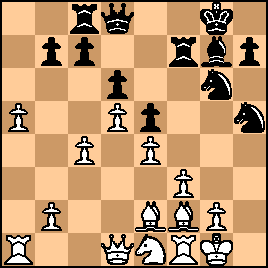Jul-15-22
 | | Fusilli: This is what annoys me about playing the KID with white. Up to move 20, white has played following theory and thematic plans and has a winning advantage (the computer says +3). He has two extra pawns and black's attack is objectively meager.
click for larger viewBut here the best move is, the computer says, the gutsy 21.f4. It does make sense... it frees up white squares for white's bishop, the f3-square for the knight, letting white pieces maneuver in defense comfortably. The pawn be damned. BUT... that doesn't mean that f4 comes so naturally. Instead, white plays the inferior 21.g3. It is understandable why white played that. It looks scary to let black occupy f4 with a knight. But then all black has to do is play a natural move (21... Qg5) to equalize... IF white plays, again, 22.f4. But white, again, lets his instinct reject the crazy-looking f4 (a square aimed at by FIVE black pieces) and plays the hapless 22.Ng2. Black again makes a natural move (22...Nxg3) and now he has huge attack. This kind of situation has happened to me many times in blitz, playing this opening with white. I follow theory and themes, I get a big positional advantage, but all black has to do anyway is to just send up pawns and pieces on the kingside and white has to play EXTREMELY precise or his position collapses. On the other hand, black does not need to play precise at all. He can just push pawns up randomly, or simply occupy the g-file with a rook, put the queen anywhere on the kingside, and throw his knights up the board, and even if black is not even thinking about what he is doing, the onus of precision is always on white. But if white gets it right, he wins. I've been learning to play the defense moves that work, but I have found that instruction material on how to play the KID with white almost never explains well how to defend from the storm on the kingside. This must be why the KID is so popular among club players but not GMs. GMs know how to extinguish the crazy fires that black tries to light, but club players are not so good at that. |
Jul-15-22
 | | perfidious: <Fusilli>, reading your mention of the computer eval brought Anand vs Nakamura, 2011 to mind. As White, I usually played the Saemisch and seldom went in for the Classical lines, cos guess what Black does not get after 5.f3? In the first half of the 1990s, I played the KID for a few years and enjoyed the K-side avalanche those times I managed it. Objectively, it is likely better for White, but as you say, one misstep and it is all up with him. |
| Jul-18-22 | | areknames: < On the other hand, black does not need to play precise at all. He can just push pawns up randomly, or simply occupy the g-file with a rook, put the queen anywhere on the kingside, and throw his knights up the board> Hehe, some pertinent points there <Fusilli>! I remember a few blitz/rapid games where I would lose all my Q side pawns plus a few pieces but what did that matter when I had a mating attack on the K side? <perf>, the Saemisch posed a different set of challenges for the enthusiastic KID player. I loved to meet it with the sharp Panno variation which one needed to know very well, most White players expected the classic 6...e5 and weren't always well prepared for 6...Nc6. |
Jul-18-22
 | | Fusilli: <areknames> The funny thing is that white does not need to massacre the queen side. The endgame with the a and b pawns and the black pawn fixed on the d6-e5-f4 chain tends to be quite bad for black even with even material. If the kingside attack vanishes, black is left with a bad bishop and white is likely to butcher the queenside pawns and win easily. But of course, again, white needs very precise defensive skills before he can cash in on the queenside. |





































